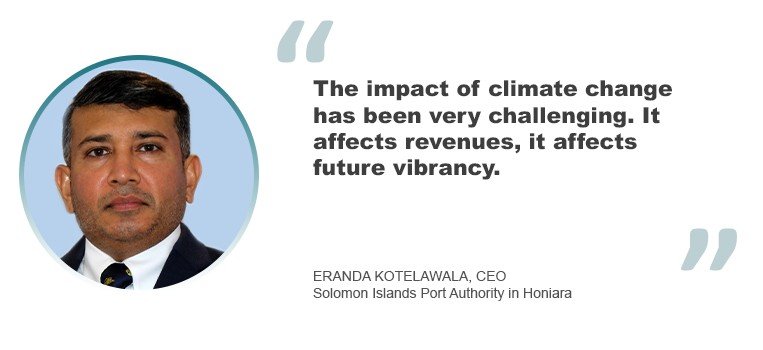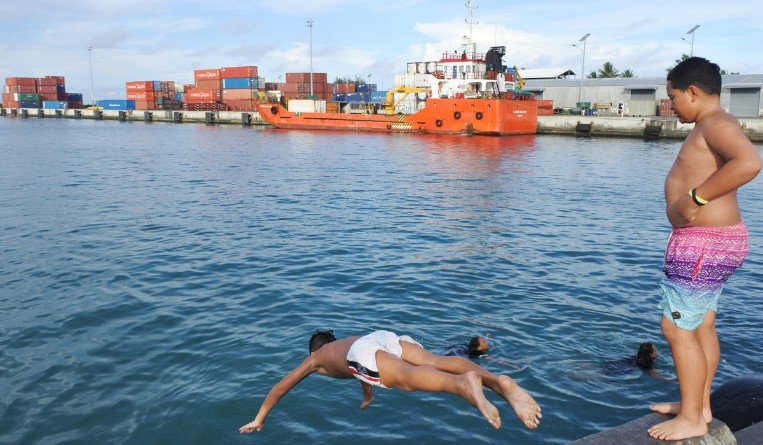Ahead of November’s COP26 UN Climate Change Conference, the more immediate consequences of climate change, especially for Pacific ports, were discussed in a Transport Events webinar.
Ports in the Pacific are already experiencing acute consequences from climate change. Not only do rising sea levels impact the efficiency of ports, but more volatile weather is a nasty complication, Eranda Kotelawala, CEO of the Solomon Islands Port Authority in Honiara, told the webinar.
No one can doubt sea levels are rising, as five islands in the archipelago have already disappeared and six others are badly eroded, Kotelawala said. “The impact of climate change has been very challenging,” he added.
Nor do the consequences stop there. Storm surges and high winds associated with climate change affect the port’s productivity he reported. Increasing sea surface salinity means that some equipment such as fenders have to be changed more frequently than in the past. Sedimentation rates are also a growing problem.
And just to drive home his point, all this has economic consequences. “It affects revenues, it affects future vibrancy,” said Kotelawala.
Strategies to deal with the problem are to hand, though, Kotelawala suggested, beginning with a climate risk and vulnerability assessment to understand the risks, then building resilient, climate-proofed infrastructure; energy efficiency; and increased use of renewables and access to climate finance as positive options for better resilience.
Elaboration on this point came from K. Subramaniam, general manager of Malaysia’s Port Klang Authority in Petaling Jaya, who made the point that such problems are not just confined to the Pacific, and underscored the costs and problems these changes are bringing.
Among his suggestions for improving ports were cleaner bunker fuel; more use of low-sulphur, LNG and biofuels; on-shore power supplies and more renewable sources of energy. He also suggested installing water-permeable pavements to better deal with increasing storm- and rainwater.
Port Klang is not just looking at being energy efficient, but is considering going further with its own renewable facilities such as solar, wind and biomass. “We are in a transition mode when we are replacing some of the energy,” said Subramaniam.
In this, it is not alone. The Cook Islands is considering installing solar panels on its ship terminal, Noora (Bim) Tou, chief executive officer of the Cook Islands Ports Authority in Rarotonga, told the webinar.
One of the other areas where there is scope for change and saving is the use of digitization to allow quicker and more efficient movement of ships – and, therefore, fewer emissions, Subramaniam added.
Shipping is also stepping up to play its part with the leadership role of the International Maritime Organization (IMO) a UN body tasked with regulating the world’s merchant marine fleet, giving it a sharper focus albeit for a growing problem.
Shipping’s share is just under 3% of global emissions – 2.89%, up from 2.7% in 2012. Such a margin sounds small, but the industry used 213 million tonnes of fuel in 2019, according to the statistics it collected, said Roel Hoenders, head of the IMO’s Air Pollution and Energy Efficiency Marine Environment Division in London.
“More action is needed,” Hoenders added, especially as the IMO has ambitious targets of cutting carbon intensity by 40% by 2030 and reducing total emissions by 50% by 2050. Both goals are set against a 2008 baseline, all while taking into account the goals of less-developed countries and the special requirements of small islands.
Among the actions the IMO is planning include its future greenhouse gas reduction measures, which will require ships to move away from fossil bunker fuels and to take up alternative low-carbon fuels such as renewably produced ammonia, hydrogen, methanol and batteries.
This might sound far-fetched, but as Hoenders pointed out, the future is already here with Maersk saying it will use methanol in eight new ships. These will be built by Hyundai Heavy Industries and introduced to the Maersk fleet in the first quarter of 2024. They are, as Maersk said in a statement, “a groundbreaking series of eight large ocean-going container vessels capable of being operated on carbon neutral methanol.”
The vessels will each have a nominal capacity of approximately 16,000 TEUs and have a dual fuel engine setup.
“The series will replace older vessels, generating annual CO2 emissions savings of around 1 million tonnes. As an industry first, the vessels will offer Maersk customers truly carbon neutral transportation at scale on the high seas,” the statement said.
It is both a sign of the things to come and a hint of the scale of changes coming the industry’s way.

Michael Mackey



